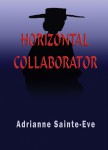Horizontal Collaborator by Adrianne Sainte-Eve
“Horizontal Collaborator” takes place in Europe, from the turn of the twentieth century through World War I. Readers are introduced to the eccentric lifestyle of the Hungarian nobility, which still has its roots in the feudal system, and is sharply contrasted to the childhood of Gabrielle Violette Clary, the story’s protagonist, an illegitimate peasant born in the countryside of Lorraine in France.
Violette, a streetwise Parisienne, revels in the unconventional café life of the period. She scratches out a living as a barmaid in Montmartre, amid surroundings that attract artists and bohemians as well as a wide variety of other characters, some intelligent, worldly people, and some who are merely bizarre. During her youthful adventures, she has a brief affair with a Hungarian Hussar officer, who figures later as an influential character in the story.
Through her dubious connections, she has an opportunity to work for the French Chief of the Fifth Bureau as a double agent during the war. Despite the misgivings of the Entente, her chief dispatches her to Spain with instructions to do what she can to infiltrate the German intelligence network, which is known to be headquartered there. After a brief training course in “spy school,” Violette boldly embarks on her ambitious undertaking armed only with her street brashness and extreme naiveté.
Violette subsequently becomes the mistress of the chief of German Naval Intelligence, Baron Leo von Beringer. Her assurance is tested as she wonders how far she can go in her deception of an extremely high-ranking German officer. Though she tries to maintain a professional distance, she is alternately attracted to and repulsed by Leo, who has many admirable traits, as well as some vile qualities. The reader will consider whether Violette is falling under Leo’s charismatic spell, and actually which side she is really on and wonder how long a German career officer will allow himself to be fooled by a naive young Frenchwoman, no matter how cunning and elusive.
As the story unfolds, the reader will become aware of a theme of interconnectedness between the characters though they are widely scattered throughout France, Spain, and the great empires of Prussia and Austria-Hungary. The reader follows the various threads of their lives as they converge and begin to appreciate that everyone from the slum-dwellers of Paris to foreign aristocracy is a victim of his own filters and illusions.
Violette reconnects with Zoltán, the handsome Hussar, and another disastrous chain of events begins. As she navigates through sharply contrasting class differences and various cultures, we see the characters’ bizarre similarities as well as their differences, they are filled with contradictions, nothing is simply black-or-white, that everyone alive is shackled by his or her own endless misperceptions and delusion, and that lives are connected in mysterious and seemingly coincidental ways.
As the war drags on, Violette senses that Leo’s infatuation is declining, and she tries to plan her escape. However, another character from Violette’s past turns up and complicates everything. She realizes her position is much more dangerous than she had thought, and that she can expect very little help from the French government. Fate throws her into an unexpected connection with Leo’s stepdaughter, Angèle, who also turns out to be Zoltan’s stepsister.
The author, Adrianne Sainte-Eve was born in Budapest, Hungry, and spent her childhood in Quebec, Regina, Saskatchewan and Vancouver, Canada. She graduated from the Art Institute of Chicago, where she still lives.
“I read constantly and read everything. The idea of women spies during WW1 intrigued me. When I read “The Skylark” it struck me that for Ladoux the topic of interest was the war. I was more interested in the character’s individual personalities and their lives. I wanted to know what they thought, these people who were on opposite sides of the war. I wanted their perspectives. This woman had an entire life besides being a spy for a while. What happened before and after? One day I suddenly thought I could absolutely do this and just started. I kept at it because I really enjoyed it. No one was more surprised than I was when it was finished,” Sainte-Eve said.
Alister Lang, Books Considered, said: “One might not guess that Sainte-Eve is a first-time novelist. Her characters are full of life and well thought out. I am looking forward to Sainte-Eve’s next book.”
*****
 Adrianne Sainte-Eve was born in Budapest Hungary, and spent her childhood in, Quebec, Regina, Saskatchewan, and Vancouver, B.C. in Canada. She is a graduate of the Art Institute of Chicago and Northern Illinois University, and currently lives in Chicago, Illinois.
Adrianne Sainte-Eve was born in Budapest Hungary, and spent her childhood in, Quebec, Regina, Saskatchewan, and Vancouver, B.C. in Canada. She is a graduate of the Art Institute of Chicago and Northern Illinois University, and currently lives in Chicago, Illinois.
- Autumn Fire by Tom Wither - September 30, 2014
- The Sun is God by Adrian McKinty - August 31, 2014
- Dirty Magic by Jaye Wells - January 1, 2014

